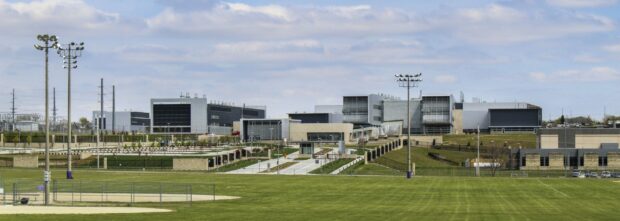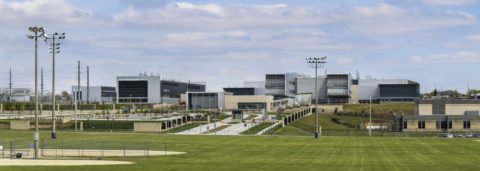HOME | ABOUT US | MEDIA KIT | CONTACT US | INQUIRE
HOME | ABOUT US | MEDIA KIT | CONTACT US | INQUIRE
The Sunflower State is capitalizing on the growth of research, development, and commercialization in the human, animal, and plant sciences.

One can’t fully appreciate where Kansas sits at the center of life sciences excellence in 2022 and think about where that might take the state going forward without looking backward. So do a little time traveling here:
• In 2004, the first formal efforts to codify what’s known today as the Animal Health Corridor took shape. The idea was to begin marketing the region on either side of an axis that ran from the Kansas City area north to the St. Joseph-Atchison area, an hour to the north. To the west, the corridor would extend to Manhattan, home of Kansas State University and its wealth of programs in plant science and veterinary medicine; roughly 125 miles to the east, the corridor would reach Columbia, Mo., where the University of Missouri boasted similar strengths. The payoff in 2022: More than 300 animal-health companies operate within that space. Those brands account for an estimated 60 percent of animal-health products—food and medicines—sold worldwide.
• In 2009, the federal government designated Manhattan as the new home for the National Bio and Agro-Defense Facility—NBAF–relocating from a dated installation on Plum Island, New York. The project’s cost would eventually rise to $1.25 billion over the nearly 10 years it has taken to prepare the high-security facility for its first operations this year, with more to come next year as the site fills up. The payoff? Instant recognition for Kansas as the epicenter of research into potential threats to the animal and plant links in the nation’s food chain.
• In 2012, the University of Kansas Cancer Center turned a decade-long fundraising and organizational lift into recognition from the National Institutes of Health, earning designation as a national cancer center. The payoff? The ability to attract high-level researchers and the funding to support them. That almost immediately elevated both research and clinical care in the nation’s heartland. It allows residents of this region to seek treatment locally rather than endure the rigors of trips to places like M.D. Anderson in Houston or the Mayo Clinic in Minnesota.
 On all three fronts, what began with a combined civic, private, and public-sector vision has remade Kansas into a fertile field for expansion in one of the most sought-after fields of economic development. Next to high-level financial services, life sciences pay more than you’ll find in almost any sector; biotech research jobs can easily exceed $200,000 in compensation.
On all three fronts, what began with a combined civic, private, and public-sector vision has remade Kansas into a fertile field for expansion in one of the most sought-after fields of economic development. Next to high-level financial services, life sciences pay more than you’ll find in almost any sector; biotech research jobs can easily exceed $200,000 in compensation.
Those efforts have helped make Kansas home to the largest concentration of animal health companies in the world. For animal health alone, the numbers suggest a solid foundation for future growth: more than 14,000 people are employed in animal health and related industries across Kansas. Their combined work products yield a $2.2 billion contribution to the state’s GDP, a number boosted by exports of veterinary vaccines, as Kansas ranks third nationally in that sphere.
Already, Kansas is home to a pair of major pet food producers: Hills Pet Nutrition, a $2.5 billion-a-year subsidiary of Colgate Palmolive, with more than 750 employees in Topeka. Not far to the south is Emporia, home to a Simmons Pet Foods plant that underwent a recent expansion. That allowed the plant to hire an additional 440 people in 2020, bringing the workforce there to roughly 1,300.
On the human health side, the University of Kansas is likewise nationally recognized for its drug discovery and development enterprise. The office of research and its Center for Technology Commercialization is tasked with bringing the university’s research expertise and technology to the marketplace to support industry and spur job growth. The research office’s KU Innovation Park, formerly the Bioscience & Technology Business Center, is designed to turn researchers into entrepreneurs with services to establish and grow promising companies.
K-State, the nation’s first land-grant university, has a long track record for agricultural leadership. Now, with NBAF right next door to the campus, Manhattan is poised to become a center of research into potential threats to the nation’s food supply. The consequences of that work won’t be limited to Manhattan or the state—they will be global.
What is likely to remain local is the product of commercialization efforts from research done both at NBAF and K-State’s own Biomedical Research Institute. The latter is a 113,00-square foot, high-containment facility capable of handling a variety of research with an emphasis on agricultural disease issues—for both plant and livestock.
So, where does that research go to turn into economic development?
New companies, as well as those already established, can turn to BioKansas for assistance through its comprehensive efforts focused on policy and advocacy, advice on funding pathways, and courses Lean Six Sigma, leadership and data analytics. BioKansas represents more than 140 Kansas bioscience companies, academic institutions, biotech centers, and related organizations. Their mission: To connect the Kansas bioscience community to encourage and enable the successful attraction, creation, commercialization, and growth of bioscience technologies, products, and services in the state.
Another piece of the supporting infrastructure for emerging companies is the state Department of Commerce, which partners with BioKansas to support every step of the process from the research bench to product distribution, a system that encompasses contract research and manufacturing organizations, facility design and engineering, marketing, distribution, and logistics.
That ecosystem continues to reshape commerce in the state. A recent example of those successes came with Merck Animal Health’s $100 million in facility expansion at its plant in the Kansas City suburb of De Soto. Its effort yielded a vaccine production facility that came online in 2020, with additional business lines in development over the next few years.
Merck’s 325 employees at that site are but a drop in the bucket of life-sciences employment in the state. Next door to De Soto is the city of Lenexa, which has done an exceptional job recruiting companies in that space. Among those established there are Quest Diagnostics (1,830 employees), Thermo Fisher Scientific (900), Clinical Reference Laboratory (720), and PRA Health Sciences (613).
Nearby, in Overland Park, Laboratory Corporation of America employs 700 people, and 650 more work just north of Lenexa at the Elanco Animal Health facility in Shawnee.